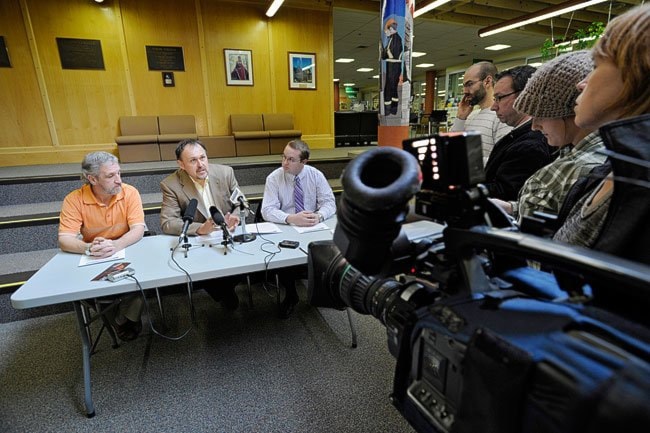The Yukon Party will build a university in the territory.
It remains unclear when this lofty goal would be accomplished or how much it would cost. But the governing party would get started if it’s re-elected, said Premier Darrell Pasloski on Wednesday.
The announcement highlighted the premier’s flexible sense of fiscal prudence.
One day earlier, during a debate hosted by environmental groups, Pasloski thundered that the opposition parties were reckless to endorse a plan to protect four-fifths of the Peel Watershed.
Why? Because they didn’t know how much it would cost.
“How can a responsible government say they’re just blindly going to do this?” Pasloski said at the time. “And they have no clue how much this is going to cost.”
But a university’s a far different proposal, said Pasloski. If anything, he expects it would help grow the economy.
“It’s going to attract more people who will come to the Yukon and pay taxes and contribute to our territory’s revenue base,” said Pasloski.
He expects Ottawa would chip in. So would mining companies, as partners in an expanded trades program.
“You can’t put a figure on it until you know exactly what model would be the right one,” Pasloski later added. He couldn’t say what the price range would be, either, or what models were being considered.
He’d let experts figure that out.
RELATED:Read all of our election coverage.
The idea of building a University of the North has been floated for five decades. Both the NDP and Liberals have, in recent years, proposed that the Yukon ought to be the institution’s rightful home.
Pasloski didn’t rule out a partnership with the Northwest Territories and Nunavut. But he did call the new project a “Yukon university.”
Early steps would be to build a new student residence. The Liberals made a similar commitment earlier this month.
The territory would also identify new land to expand the college. But Pasloski didn’t expect the territory to pay for any pricey new buildings right away.
Yukon College currently offers five degree programs in partnership with various universities.
Samson Hartland, the Yukon Party’s 32-year-old candidate for Takhini-Kopper King, says he has plenty of peers who’d be interested in attending university, but don’t want to leave the territory.
He’s currently completing an MBA program by correspondence with Thompson Rivers University of Kamloops. When he researched possible schools to attend, he wished a local option was available.
Doug Graham, the Yukon Party’s candidate for Porter Creek North, served as the territory’s Education minister 30 years ago.
“We envisioned some time in the future we’d be moving in this direction,” he said. “So it’s really nice for me to be able to come back 30 years later, hopefully, and participate in the expanded college and university.”
Some may wonder whether a university is what the territory needs, when the Yukon’s high school graduation rate straggles behind every province, and remains especially low for First Nation students.
The government is working to fix that, said Pasloski, citing a pilot program to improve rural education in Dawson City and $11 million spent over an undisclosed period on literacy programs.
Nor was Pasloski concerned about the challenge of recruiting staff.
As the news announcement at Yukon College wrapped up, Pasloski was drawn off topic by a reporter who asked about his position on the Peel Watershed. Pasloski repeated his criticism of the opposition parties, which support the protection plan.
“They agreed to a plan before there even was a plan,” said Pasloski. “But they don’t know how they’re going to implement it. And they have no clue as to what the cost of this will be.
“It would be like you saying, ‘I’m going to buy a house,’ without even knowing what the cost is, or whether you could afford to buy a house.’”
Or, it was put to him, like planning to build a university without knowing the cost?
“We’re committed to the university. We feel there’s a strong economic benefit to the university.”
Thomson Centre
re-opens, for real
The Thomson Centre began admitting elderly residents one week ago and is expected to be fully occupied by October 19.
The continuing-care facility, adjacent to Whitehorse General Hospital, officially reopened in late August. But was shuttered again after an air-quality test found mould spores.
That sounded bad. The government has spent many years, and many millions of dollars trying to rid the building of mould, fix water leaks and patch other problems.
The Thomson Centre was built in 1993 by Tony Penikett’s NDP government. For the past nine years, its rooms built to provide care to the elderly have sat empty.
But experts didn’t find much of concern, said Pat Living, a Health spokesperson.
“They did find a small amount of mould, because of a leaky shower,” said Living. “They fixed that right away. But there was no belief on the part of the experts that we couldn’t go into the facility.”
Problems with the building’s fire alarm caused more delay. But that’s also been fixed.
The Yukon Party originally promised to have the Thomson Centre open by February of 2007. But it faced a succession of setbacks with meeting building code, so the government instead focussed on filling Copper Ridge’s 96 beds.
This year’s budget included $3.3 million to complete work to the Thomson Centre.
Contact John Thompson at
johnt@yukon-news.com.
